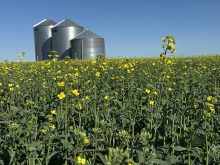Nitrogen for the 2006 crop is going to cost a lot of money and producers are wondering whether they should buy now or wait until spring.
Nitrogen fertilizer prices are at the point where “the industry has never seen this high before,” said Ken MacQuarrie, who heads Agricore United’s farm inputs division. “What we can do about it is another matter.”
Buying fertilizer this fall locks in present high prices, but ensures supply.
MacQuarrie said there are times when farmers can buy in the fall and save money.
Read Also

Huge Black Sea flax crop to provide stiff competition
Russia and Kazakhstan harvested huge flax crops and will be providing stiff competition in China and the EU.
According to Alberta Agriculture price reports, in four of the past five years the price of 46-0-0 urea in the fall was marginally lower than in the spring. The exception was 2001-02.
However the cost of handling and storage combined with carrying costs can undermine fall purchase savings.
Buying in the fall can reduce taxable income, said Western Producer columnist Allyn Tastad, a Saskatoon certified general accountant.
“It can help, but don’t buy more of a deduction than you can use,” he said.
Claims under the Canadian Agricultural Income Stabilization program are unaffected by year-end purchases because the expense is offset by an inventory increase.
Natural gas futures prices on the New York Mercantile Exchange can provide a clue about where nitrogen prices are headed.
Nitrogen fertilizer prices are strongly influenced by the price of natural gas, comprising up to 90 percent
of the total production cost.
The exchange’s futures for January and February are five to seven percent higher than current gas prices. The April contract is a little lower, but that wouldn’t affect fertilizer production targeted at the spring planting season.
Fertilizer manufacturers consume only about three percent of all gas production in North America, which leverages little buying power for the raw material.
Manufacturers hedge the price of their natural gas, but gas prices have increased annually for several years. Hurricane damage in the gas-rich U.S. gulf coast this fall has further increased production costs, driving urea fertilizer prices above $550 per tonne.
But energy price volatility means even that indicator may not be the final word on spring pricing. They could even drop.
“Rock and roll energy prices could mean lower priced fertilizer in the spring,” said Don Flaten, who teaches plant fertility at the University of Manitoba.
“But you have to look at the long-term trend of higher (fertilizer) prices year after year compared to farm commodities and think it will continue up. If not spring 2006, up later on.”
The message is to use fertilizer in the most effective manner possible, he said.
“Producers can buy and store it on the farm, at the dealer or in the ground. Or they can wait and buy in the spring,” he said.
Benefits of fall
Storing fertilizer in the field is normally one of the best ways of locking in a fall price while reducing field operations in the spring.
However, this season many areas from the foothills to the Ontario border have saturated soils and risks are high of losing fall-applied fertilizer to denitrification or leaching.
“If you are looking to place fertilizer in the ground this fall, then waiting until soil temperatures are as low as possible will keep losses to a minimum in wet or dry soils,” said Flaten.
New research at the U of M confirms that producers can reduce fall losses by not placing nitrogen in wet soils too early in the season.
The research also shows dry soils can accept nitrogen early in the fall without significant losses.
MacQuarrie said producers should use a soil test to manage their fall inputs decision.
“You need to know where to invest and how much this year. At these prices you can’t afford to guess,” he said.
Agronomists say producers trying to reduce their input costs should focus on maximizing yields with balanced applications of building block nutrients.
“This may be a year to focus on the (nitrogen, phosphorus, potassium and sulfur) and not so much on the copper and zinc and other micronutrients,” said MacQuarrie.
“Get the biggest bang for your buck.”
Natural gas prices have tripled in four years and traders say the price is unlikely to level off until 2008. That is when the first of more than 50 liquefied natural gas facilities begin to open in ports around North America to accept international imports.
















